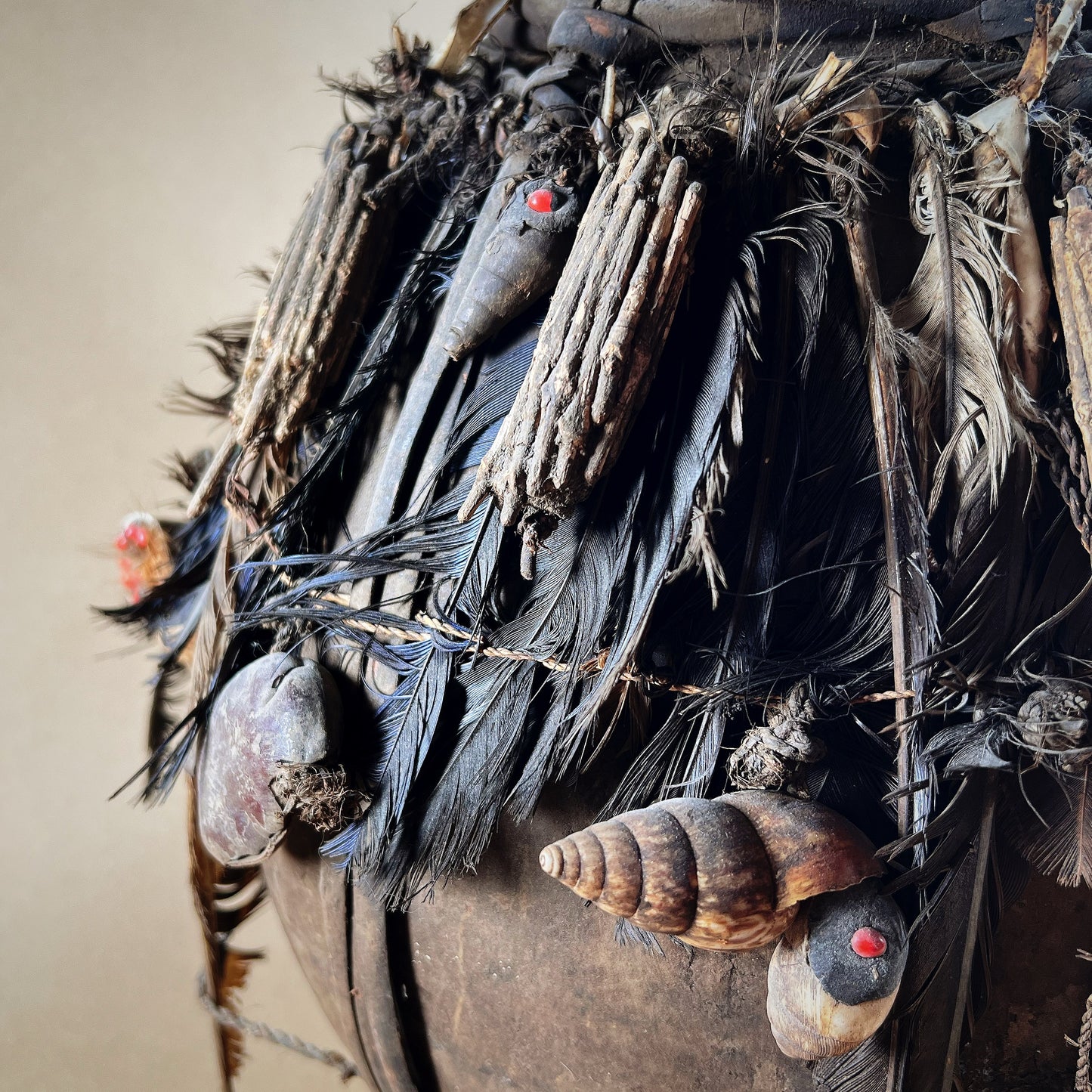Mambila or Bamum Healer's Calabash Pitcher
Mambila or Bamum Healer's Calabash Pitcher
Couldn't load pickup availability
Mambila or Bamum people, early to mid. 20th century, Cameroon Grasslands, Central Africa
Magnificent ritual calabash pitcher used by healers or diviners in the Cameroon Grasslands. A large spherical calabash vessel with a long neck, securely set within a finely woven basketry holder with a side handle. The bulbous body is richly adorned with bones, a small monkey skull, snail shells, plant seeds, medicine packets, feathers, and other sacred attachments—materials traditionally added to activate and enhance the spiritual potency of the vessel.
The Cameroon Grasslands is inhabited by a wide range of interrelated peoples, most commonly grouped into Bamum, Bamenda Tikar, and Bamileke cultural complexes. Within these are numerous smaller communities with long-standing traditions of ancestor veneration, healing practices, and divination.
The Bamum people, living near the Nbam and Nun rivers, believe in a supreme creator god, Njinyi, who is omnipresent and all-seeing. Bamum healers practise earth-spider divination, interpreting the creature’s movements across marked leaves. Ancestors remain central to social and spiritual life; their spirits are believed to reside within preserved skulls. When skulls are not kept or honored properly, the spirits may become restless and troublesome. Because of this, representations of heads are common in Bamum ritual objects and utilitarian art forms, symbolizing the presence and guidance of ancestral forces.
The Mambila people inhabit areas on both sides of the Nigeria–Cameroon border, most living on the Mambila Plateau in Nigeria, with others on the Cameroonian foothills and Tikar Plain. Their spiritual life includes beliefs in witchcraft, spider or crab divination (ngam), and rituals linked to lunar cycles. They revere a creative god (càng or nama), but direct worship is primarily focused on ancestors. At death, a person’s spirit is believed to leave the body and be driven into the bush (tandalu), becoming a “spirit of the bush” (càng tandalu). Leaders were sometimes buried in attic lofts, symbolizing the prosperity they brought to the household.
Much of Mambila ritual art is associated with the Sùàgà (Sua) society, an influential institution responsible for healing, fertility, ritual cleansing, justice, and the protection of the community from witchcraft or hostile forces.
This extraordinary calabash pitcher—densely charged with symbolic attachments and ritual materials—stands as a powerful example of Grasslands spiritual and divinatory tradition.
Excellent condition. Heavy encrusted surface. Age-related wear and abrasion. Signs of use and handling over many years. Strong black oily and sooty patina, originating from ritual use. Size approx. 61,0cm x 31,0cm x 33,0cm.
Provenance: Finnish private collection
For a similar example see:
African Collection of the Virginia Museum of Fine Arts (VMFA), Accession number: 2010.7a-b (https://vmfa.museum/piction/6027262-52282614/)






-
Shipping
The shipment will be prepared in the course of 3-5 days and dispatched via Posti Group Oyj or purchased item(s) can be picked up from our shop during the store's opening hours (Tarkk’ampujankatu 4, 00140, Helsinki, Finland). Within the Finland, all items are shipped via Posti Group Oyj unless otherwise requested. We pack the items carefully and mainly in recycled materials because we want to save nature. You will receive the tracking number for your items by e-mail.
-
Returns
Returns and exchange will be accepted within fourteen days (14) of receipt at the purchaser’s cost to include freight and packaging. Items must be returned in the same condition as when they were shipped, and will not be accepted if damaged or altered in any way. Please inform us via email (info@gotanmaailma.fi) or by calling +358408408352 before sending. We do not accept returns more than 14 days after delivery.






